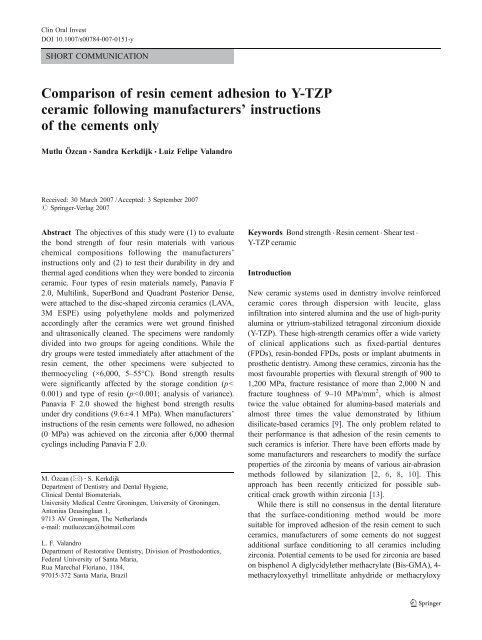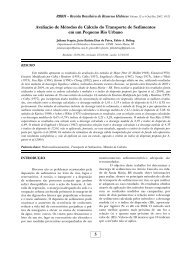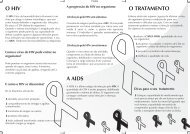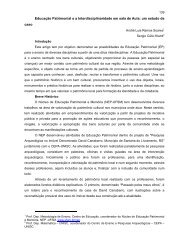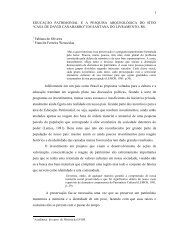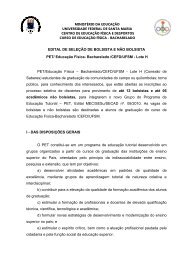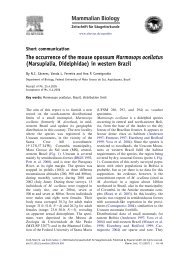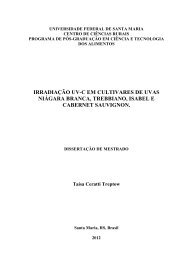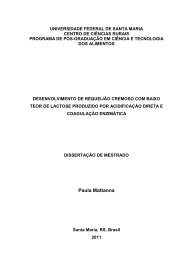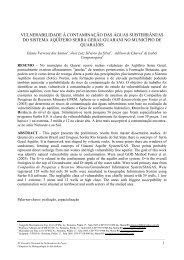Comparison of resin cement adhesion to Y-TZP ... - ResearchGate
Comparison of resin cement adhesion to Y-TZP ... - ResearchGate
Comparison of resin cement adhesion to Y-TZP ... - ResearchGate
You also want an ePaper? Increase the reach of your titles
YUMPU automatically turns print PDFs into web optimized ePapers that Google loves.
Clin Oral Invest<br />
DOI 10.1007/s00784-007-0151-y<br />
SHORT COMMUNICATION<br />
<strong>Comparison</strong> <strong>of</strong> <strong>resin</strong> <strong>cement</strong> <strong>adhesion</strong> <strong>to</strong> Y-<strong>TZP</strong><br />
ceramic following manufacturers’ instructions<br />
<strong>of</strong> the <strong>cement</strong>s only<br />
Mutlu Özcan & Sandra Kerkdijk & Luiz Felipe Valandro<br />
Received: 30 March 2007 /Accepted: 3 September 2007<br />
# Springer-Verlag 2007<br />
Abstract The objectives <strong>of</strong> this study were (1) <strong>to</strong> evaluate<br />
the bond strength <strong>of</strong> four <strong>resin</strong> materials with various<br />
chemical compositions following the manufacturers’<br />
instructions only and (2) <strong>to</strong> test their durability in dry and<br />
thermal aged conditions when they were bonded <strong>to</strong> zirconia<br />
ceramic. Four types <strong>of</strong> <strong>resin</strong> materials namely, Panavia F<br />
2.0, Multilink, SuperBond and Quadrant Posterior Dense,<br />
were attached <strong>to</strong> the disc-shaped zirconia ceramics (LAVA,<br />
3M ESPE) using polyethylene molds and polymerized<br />
accordingly after the ceramics were wet ground finished<br />
and ultrasonically cleaned. The specimens were randomly<br />
divided in<strong>to</strong> two groups for ageing conditions. While the<br />
dry groups were tested immediately after attachment <strong>of</strong> the<br />
<strong>resin</strong> <strong>cement</strong>, the other specimens were subjected <strong>to</strong><br />
thermocycling (×6,000, 5–55°C). Bond strength results<br />
were significantly affected by the s<strong>to</strong>rage condition (p<<br />
0.001) and type <strong>of</strong> <strong>resin</strong> (p
decyl phosphoric acid (MDP) monomers. The dilemma for<br />
the clinicians remains whether <strong>to</strong> follow the manufacturers’<br />
instructions <strong>of</strong> the <strong>cement</strong>s during <strong>cement</strong>ing the FPDs<br />
made <strong>of</strong> zirconia or modify the instructions and follow the<br />
instructions <strong>of</strong> some manufacturers that suggest separate<br />
surface-conditioning pro<strong>to</strong>cols.<br />
Therefore, the objectives <strong>of</strong> this study were <strong>to</strong> evaluate (1)<br />
the bond strength <strong>of</strong> four <strong>resin</strong> materials with various chemical<br />
compositions following the manufacturers’ instructions only<br />
and (2) <strong>to</strong> test their durability under dry and thermally aged<br />
conditions. The tested hypothesis was that thermocycling<br />
would decrease the bond strength <strong>of</strong> all <strong>resin</strong>s.<br />
Materials and methods<br />
Disc-shaped (diameter=15 mm, thickness=2 mm) Y-<strong>TZP</strong><br />
ceramics (LAVA, 3M ESPE, Seefeld, Germany) were<br />
embedded in polyethylene molds using polymethylmethacrylate<br />
(PMMA; Condular AG, Wager, Switzerland) with<br />
one side <strong>of</strong> the disc exposed for adhering the <strong>cement</strong><br />
(Fig. 1). They were ground finished up <strong>to</strong> 1,200-grit<br />
silicone carbide abrasive under water cooling and ultrasonically<br />
cleaned in distilled water for 3 min.<br />
The discs were randomly divided in<strong>to</strong> eight groups<br />
depending on the <strong>cement</strong> type and the ageing condition <strong>to</strong><br />
be applied (N=80, n=10/per group; Table 1). Four types <strong>of</strong><br />
<strong>resin</strong> materials were chosen: a light-polymerized (Panavia F<br />
2.0, Kuraray, Medical Inc., Osaka, Japan), self-adhering<br />
(Multilink Ivoclar Vivadent, Schaan, Liechtenstein) and<br />
chemically polymerized <strong>cement</strong> (SuperBond, Sun Medical,<br />
LTD, Tokyo, Japan) where the <strong>resin</strong> composite (Quadrant<br />
Posterior Dense, Cavex, Harlem, The Netherlands) acted as<br />
the control material.<br />
Fig. 1 The Y-<strong>TZP</strong> disc specimen was embedded in the PMMA with<br />
the <strong>cement</strong>ation surface exposed. Cement was applied incrementally,<br />
not exceeding 2 mm, <strong>to</strong> the surface using polyethylene molds (inner<br />
diameter=3.6 mm, height=5 mm) and polymerized accordingly<br />
Table 1 Testing groups considering the types <strong>of</strong> <strong>resin</strong> <strong>cement</strong>s and<br />
the s<strong>to</strong>rage conditions (dry vs thermocycling—TC)<br />
Type <strong>of</strong> <strong>resin</strong> <strong>cement</strong> S<strong>to</strong>rage condition a<br />
Panavia F 2.0 b<br />
Multilink c<br />
Superbond d<br />
Quadrant Posterior Dense e<br />
Shear bond test<br />
The specimens were placed in the jig <strong>of</strong> the universal<br />
testing machine (Zwick ROELL Z2.5 MA 18-1-3/7 Ulm,<br />
Germany), and load was applied <strong>to</strong> the adhesive interface<br />
until failure occurred (crosshead speed=1.0 mm/min). The<br />
maximum force <strong>to</strong> produce fracture was recorded (N/mm 2 =<br />
MPa) using the corresponding s<strong>of</strong>tware.<br />
Statistical analysis<br />
Dry Gr1<br />
TC Gr2<br />
Dry Gr3<br />
TC Gr4<br />
Dry Gr5<br />
TC Gr6<br />
Dry Gr7<br />
TC Gr8<br />
Clin Oral Invest<br />
Testing groups<br />
a Dry condition—Shear test was performed immediately after <strong>cement</strong>ation;<br />
TC condition—6,000 cycles between 5 and 55°C in deionized grade<br />
3 water. The dwelling time at each temperature was 30 s, and the transfer<br />
time from one bath <strong>to</strong> another was 2 s (Willytech, Gräfelfing, Germany).<br />
b (1) Conditioning the ceramic using chair-side air-particle abrasion<br />
device with 50 μm Al 2O 3 for 15 s making circular movements from a<br />
distance <strong>of</strong> 10 mm; (2) rinsing the surface for 20 s with water and air<br />
drying for 5 s; (3) mixing equal amounts <strong>of</strong> paste A and B from the<br />
Panavia F 2.0 with a <strong>cement</strong> spatula for 20 s; (4) application <strong>of</strong> the<br />
mixed <strong>cement</strong> in the polyethylene mould on<strong>to</strong> the ceramic surface<br />
incrementally; (5) light polymerization (light output=500 mW/cm 2 )<br />
<strong>of</strong> each increment for 20 s (Astralis ® 5, Ivoclar Vivadent AG, Schaan,<br />
Liechtenstein).<br />
c (1) Rinsing the surface for 20 s with water and air drying for 5 s; (2)<br />
applying Monobond-S on the ceramic surface with a microbrush,<br />
waiting 60 s and air drying; (3) application <strong>of</strong> the mixed <strong>cement</strong> in the<br />
polyethylene mould on<strong>to</strong> the ceramic surface incrementally (Ivoclar<br />
Vivadent AG, Schaan, Liechtenstein).<br />
d (1) Rinsing the surface for 20 s and air drying for 5 s; (2) applying<br />
the Porcelain Liner M <strong>to</strong> the surface with a microbrush; (3) Mixing<br />
four drops <strong>of</strong> Quick Monomer, one drop <strong>of</strong> Catalyst S and one small<br />
scoop <strong>of</strong> the <strong>cement</strong> powder with a brush; (4) application <strong>of</strong> the mixed<br />
<strong>cement</strong> in the polyethylene mould on<strong>to</strong> the ceramic surface incrementally;<br />
(5) waiting for polymerization for 6 min (Sun Medical Co., LTD,<br />
Moriyama, Japan).<br />
e (1) Rinsing the surface for 20 s and air drying for 5 s; (2) application <strong>of</strong><br />
the mixed <strong>cement</strong> in the polyethylene mould on<strong>to</strong> the ceramic surface<br />
incrementally; (3) light polymerization (light output=500 mW/cm 2 )<strong>of</strong><br />
each increment for 40 s (Astralis ® 5, Ivoclar Vivadent AG, Schaan,<br />
Liechtenstein; Cavex, Haarlem, The Netherlands).<br />
Two-way analysis <strong>of</strong> variance (ANOVA) and post-hoc<br />
multiple comparisons were used <strong>to</strong> analyze the data (SPSS<br />
for Windows Version 10.05; SPSS, Chicago, IL) with the<br />
shear bond strength as the dependent variable. p values less
Clin Oral Invest<br />
than 0.05 were considered <strong>to</strong> be statistically significant in<br />
all tests. Multiple comparisons were made using Tukey’s<br />
adjustment test.<br />
Results<br />
Bond strength results were significantly affected by the<br />
s<strong>to</strong>rage condition (p
References<br />
1. Abo-Hamar SE, Hiller KA, Jung H, Federlin M, Friedl KH,<br />
Schmalz G (2005) Bond strength <strong>of</strong> a new universal self-adhesive<br />
<strong>resin</strong> luting <strong>cement</strong> <strong>to</strong> dentin and enamel. Clin Oral Investig<br />
9:161–167<br />
2. Amaral R, Özcan M, Bottino MA, Valandro LF (2006) Microtensile<br />
bond strength <strong>of</strong> a <strong>resin</strong> <strong>cement</strong> <strong>to</strong> glass infiltrated zirconiareinforced<br />
ceramic: the effect <strong>of</strong> surface conditioning. Dent Mater<br />
22:283–290<br />
3. Amaral R, Özcan M, Valandro LF, Balducci I, Bottino MA (2007)<br />
Effect <strong>of</strong> conditioning methods on the microtensile bond strength<br />
<strong>of</strong> phosphate monomer-based <strong>cement</strong> on zirconia ceramic in dry<br />
and aged conditions. J Biomed Mater Res B (Aug 6; [Epub ahead<br />
<strong>of</strong> print])<br />
4. Blatz MB, Sadan A, Martin J, Lang BR (2004) In vitro evaluation<br />
<strong>of</strong> shear bond strengths <strong>of</strong> <strong>resin</strong> <strong>to</strong> densely-sintered high purity<br />
zirconium-oxide ceramic after long-term s<strong>to</strong>rage and thermal. J<br />
Prosthet Dent 91:356–362<br />
5. Kern M, Thompson VP (1995) Bonding <strong>to</strong> glass infiltrated<br />
alumina ceramic: adhesive methods and their durability. J Prosthet<br />
Dent 73:240–249<br />
Clin Oral Invest<br />
6. Kern M, Wegner SM (1998) Bonding <strong>to</strong> zirconia ceramic:<br />
<strong>adhesion</strong> methods and their durability. Dent Mater 14:64–71<br />
7. Matinlinna JP, Lassila LVJ, Özcan M, Yli-Urpo A, Vallittu P<br />
(2004) An introduction <strong>to</strong> silanes and their clinical applications in<br />
dentistry. Int J Prosthodont 17:155–164<br />
8. Özcan M, Vallittu PK (2003) Effect <strong>of</strong> surface conditioning<br />
methods on the bond strength <strong>of</strong> luting <strong>cement</strong> <strong>to</strong> ceramics. Dent<br />
Mater 19:725–731<br />
9. Tinschert J, Zwez D, Marx R, Anusavice KJ (2001) Structural<br />
reliability <strong>of</strong> alumina-, feldspar-, leucite-, mica- and zirconiabased<br />
ceramics. J Dent 28:529–535<br />
10. Valandro LF, Özcan M, Bottino MC, Bottino MA, Scotti R, Della<br />
Bona A (2006) Bond strength <strong>of</strong> a <strong>resin</strong> <strong>cement</strong> <strong>to</strong> high-alumina<br />
and zirconia-reinforced ceramics: the effect <strong>of</strong> surface conditioning.<br />
J Adhes Dent 8:175–181<br />
11. Wegner SM, Gerdes W, Kern M (2002) Effect <strong>of</strong> different<br />
artificial aging conditions on ceramic-composite bond strength.<br />
Int J Prosthodont 15:267–272<br />
12. Wegner SM, Kern M (2000) Long-term <strong>resin</strong> bond strength <strong>to</strong><br />
zirconia ceramic. J Adhes Dent 2:139–147<br />
13. Zhang Y, Pajares A, Lawn BR (2004) Fatigue and damage<br />
<strong>to</strong>lerance <strong>of</strong> Y-<strong>TZP</strong> ceramics in layered biomechanical systems. J<br />
Biomed Mater Res B Appl Biomater 71:166–171


